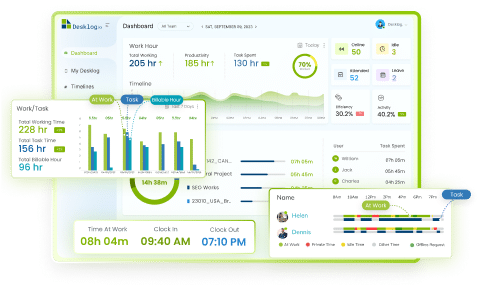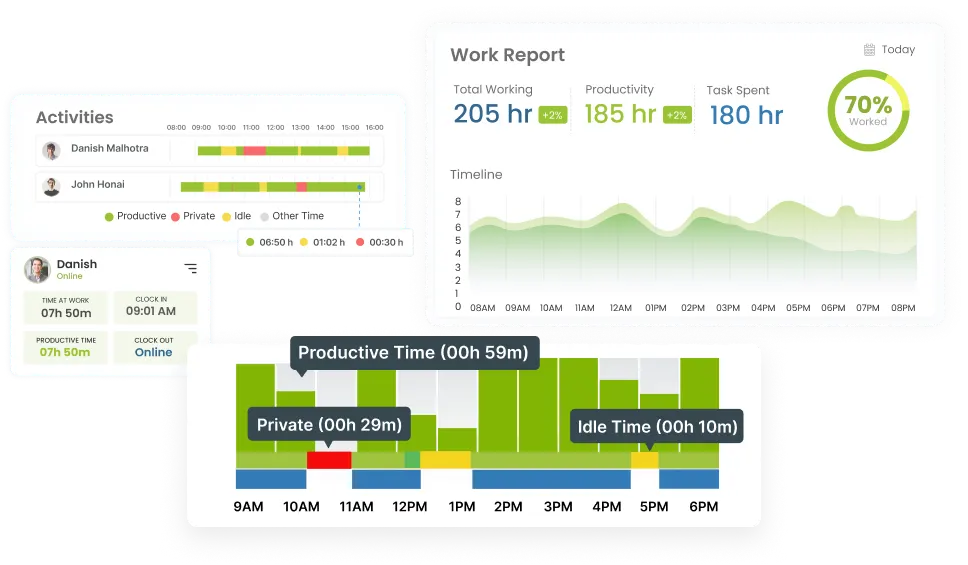Maintaining employee productivity, satisfaction, and balance is crucial for any company’s success. Central to achieving this is the fair distribution of workload among team members. As an uneven workload distribution makes employees feel unfairly treated and overwhelmed, directly impacting productivity levels.
It falls upon managers and team leaders to ensure Equitable workload distribution among the team members. And for effective workload distribution you have to follow some strategies. And that’s what exactly this blog deals with – The Strategies for effective Workload Distribution. So why wait? Join us in this ride!
What Is Workload Distribution?
Workload distribution is the process of assigning tasks and responsibilities among team members in a manner that optimizes efficiency and ensures fairness.
What Is Unbalanced Workload Distribution?

Unbalanced workload distribution refers to a scenario where tasks and responsibilities are unevenly allocated among team members, leading to disparities in workload burden and productivity. In essence, it’s the antithesis of equitable workload distribution.
Imagine a scenario where tasks are randomly assigned without consideration for individual capabilities or workload capacity. Some team members may find themselves overwhelmed with work, while others will suffer burnout, and ultimately, decreased productivity.
Conversely, if tasks are distributed solely based on seniority or personal preference, certain skill sets may be underutilized, resulting in missed opportunities for growth and innovation. This is what we call an unbalanced workload distribution. When workload distribution is unbalanced, it means that some employees are overworked while others are underutilized.
The Signs Of Unbalanced Workload Distribution
When tasks aren’t allocated equitably, it can lead to a myriad of negative consequences. But how can you tell if your team is grappling with unbalanced workload distribution?
Here are some key signs to watch out for:
Overwhelmed Team Members
One of the most obvious indicators is when certain team members consistently appear overwhelmed or stressed while others seem relatively relaxed. This suggests that tasks might not be distributed evenly across the team.
Missed Deadlines or Delays
If deadlines are frequently missed or projects are consistently delayed, it could be a sign that some team members are overloaded with work, making it difficult to meet project timelines.
Underutilized Resources
If certain team members consistently have minimal tasks or seem to be underutilized, it may indicate that workload distribution is skewed, leaving some individuals with insufficient responsibilities.
Quality Suffering
Unbalanced workload distribution compromises the quality of work. Overburdened team members may rush through tasks, leading to errors, while underutilized members may lack engagement, resulting in missed opportunities for improvement.
Increased Turnover or Burnout
High levels of stress and dissatisfaction contribute to employee burnout and turnover. If you notice a spike in absenteeism, or resignations, it’s worth investigating whether workload distribution is a contributing factor.
Unequal Workloads During Crunch Times
During busy periods or project crunch times, it’s natural for workloads to fluctuate. However, if certain team members consistently bear the brunt of the workload during these periods while others remain relatively unaffected, it may signal an underlying imbalance in workload distribution.
The Consequences Of Unbalanced Workload Distribution
When this unbalanced distribution becomes imbalanced, it sets off a chain reaction of detrimental consequences, impacting not only productivity but also team dynamics and morale.
Here are the far-reaching effects of unbalanced workload distribution:

Lower Team Performance
When some team members are overloaded with tasks while others have minimal responsibilities, it leads to an imbalance in productivity. Overworked individuals struggle to maintain the quality and efficiency of their work, while underutilized members feel disengaged and fail to contribute their full potential. This imbalance ultimately hampers overall team performance and undermines collective goals.

More Team Conflict
Unbalanced workload distribution can sow the seeds of disagreement within the team. Tensions may grow among overburdened members who feel unfairly treated, while underutilized individuals may feel undervalued or marginalized. These tensions can create conflicts, eroding trust, collaboration, and cohesion within the team.

Lower Morale
Overworked team members feel stressed, tired, and lose interest, which makes them feel less motivated and unhappy. This affects the employees’ work life balance. Additionally, underutilized members may feel boredom, which makes everyone in the team feel less excited about their work. Low morale not only undermines individual well-being but also makes it harder for the team to stay strong and make progress together

Voluntary Turnover
Perhaps the most significant consequence of unbalanced workload distribution is its contribution to voluntary turnover. When individuals feel consistently overburdened or undervalued, they may seek opportunities elsewhere, leading to talent drain and instability within the team. High turnover not only disrupts continuity and cohesion but also incurs significant costs in recruitment, training, and lost expertise.
How To Distribute Workload Equally?
Effective workload distribution is not just about dividing tasks; it’s about ensuring fairness, maximizing productivity, and nurturing a harmonious team environment. By implementing strategic methods, teams can distribute workloads equitably, harnessing the full potential of each member.
Let’s explore seven key strategies to achieve this:

Identify Workload Imbalances
The first step in achieving equitable workload distribution is to identify existing imbalances. This involves assessing each team member’s workload and comparing it against others. Look for patterns of overloading or underutilization to pinpoint areas that require adjustment.

Assess Capacity
Understanding each team member’s capacity is crucial for effective workload distribution. This entails considering factors such as skills, experience, availability, and current workload. By assessing capacity accurately, teams can allocate tasks in a way that maximizes efficiency and minimizes stress.

Prioritize Projects and Assign Tasks
Next, prioritize projects based on urgency, importance, and strategic objectives. You may follow the 1 3 5 rule to prioritize in the most efficient way. Then, assign tasks accordingly, ensuring that each team member receives a balanced mix of responsibilities aligned with their capabilities and capacity.

Involve Staff
Empower team members by involving them in the workload distribution process. Solicit their input on project prioritization, task allocation, and workload management. This not only fosters a sense of ownership and accountability but also allows for a more nuanced understanding of individual preferences and strengths.

Redistribute as Needed
Regularly reassess workload distribution to adapt to shifting priorities, unforeseen challenges, or changes in team composition. Be prepared to reallocate tasks as needed to maintain equilibrium and prevent burnout or underutilization.

Learn How to Delegate
Delegation is a cornerstone of effective workload distribution. Equip team members with the authority and resources they need to take ownership of tasks and projects. Provide clear instructions, set expectations, and offer support as needed to ensure successful outcomes.

Track Workload Metrics
Make use of data and metrics to track workload distribution and identify potential issues proactively. Track factors such as task completion times, workload capacity, and individual performance to assess the effectiveness of your distribution strategies.
By implementing these strategies, teams can foster a culture of fairness, collaboration, and productivity, laying the groundwork for sustained success.
Easily Manage Workload Distribution With Desklog
We’ve discussed the methods of effective workload distribution, but do you know there’s a tool that helps you in workload distribution?
Yes, you heard it right! It’s Desklog. Desklog can help in effective workload distribution in various ways.
Here’s how Desklog can enhance your workload distribution efforts:

Identify Workload Imbalances
Desklog provides comprehensive insights into each team member’s tasks, activities, and time spent on various tasks and projects. By analysing this data, you can quickly identify workload imbalances and take corrective action to ensure equitable distribution.

Assess Capacity
With Desklog’s time tracking features, you can accurately assess each team member’s capacity by tracking their productivity and workload levels in real-time. This allows you to allocate tasks more effectively based on individual capabilities and availability.

Prioritize Projects and Assign Tasks
Desklog enables you to create backlogs for projects, prioritize tasks based on deadlines, importance, and strategic objectives. By centralizing task management and assignment within the platform, you can ensure that workload distribution aligns with organizational priorities.

Learn How to Delegate
Desklog facilitates effective delegation by providing visibility into task ownership, progress, and completion status. Team members can track their assigned tasks, the spent time, streamlining the delegation process and ensuring accountability.
In essence, Desklog serves as a comprehensive solution for optimizing workload distribution, empowering teams to work more efficiently, collaboratively, and strategically.
In Summary
Cultivating effective workload distribution is important for a culture of productivity, collaboration, and maintaining a healthy work life balance. By implementing the strategies outlined in this blog, organizations can ensure that tasks are allocated efficiently, team members are empowered to excel in their strengths, and communication flows seamlessly.
So, as you navigate the landscape of workload distribution, remember to adapt, communicate, and prioritize wisely for sustained success.
FAQ
1What are the effective workload management strategies?
- Take regular breaks
- Split tasks into subtasks
- Limit multitasking
- Know your limits
- Schedule your tasks and set achievable deadlines
- Consider task dependencies
- Allocate time to checking emails
- Set SMART goals
2How to effectively handle a heavy workload?
Below are the strategies for managing an heavy workload:
3What are the three ways to measure workload?
The 3 ways to measure workload is
- Add up how much time each of the staff person’s projects require per week
- Compare it to how many hours they are expected to work in a week
- If the former exceeds the latter, they are overloaded.
4 How to analyze workload?
To conduct a workload analysis:
Identify all tasks and projects, Determine scope, Inspect allocation and utilization, Set a budget, Make workload and resource adjustment, and Monitor progress.
5What is the workload pressure?
Work pressure is the stress or tension encountered while managing present and anticipated works. Workload refers to how extensively our resources are utilized during tasks, acknowledging the possibility of being either underutilized or overwhelmed.

















